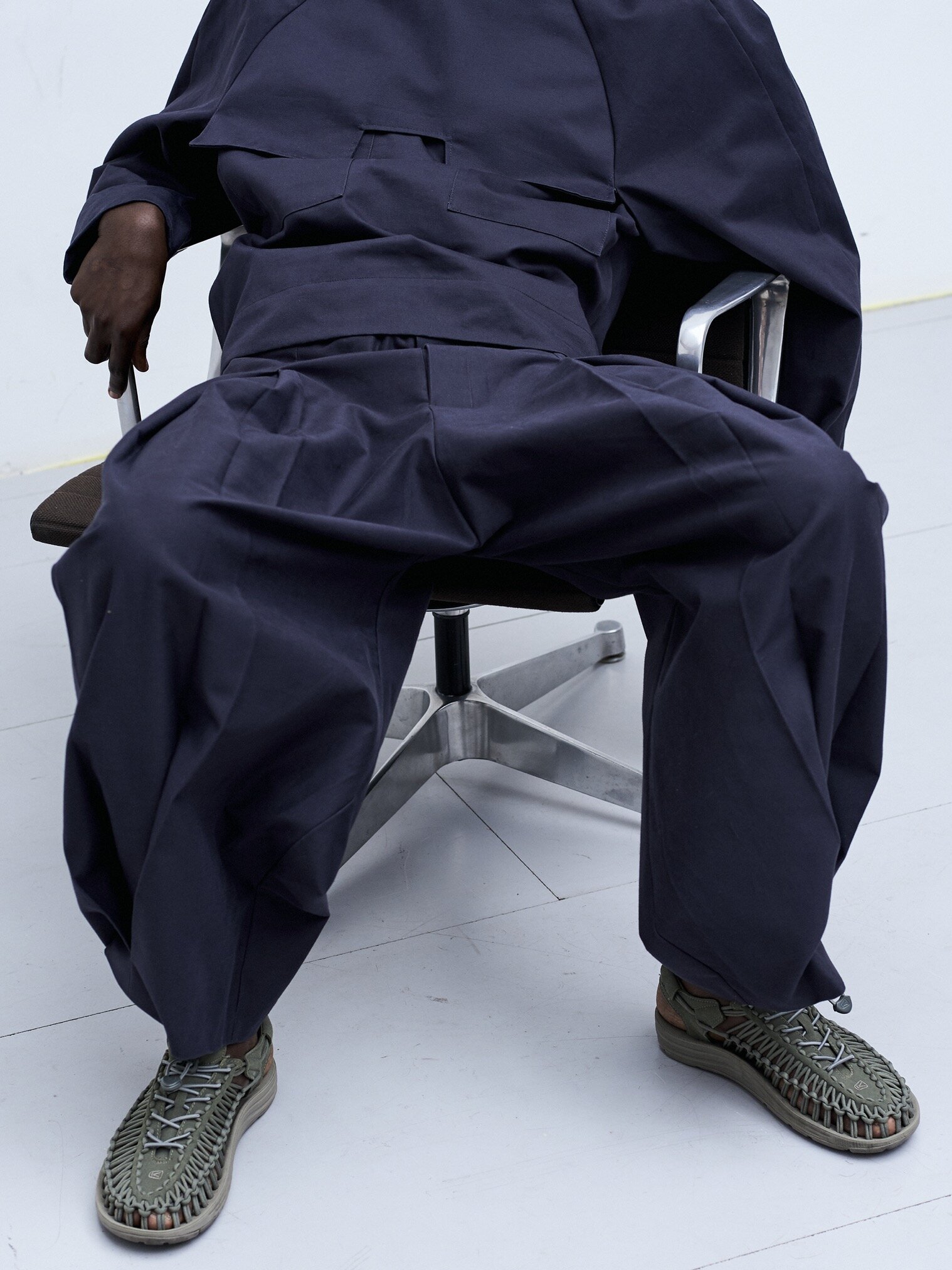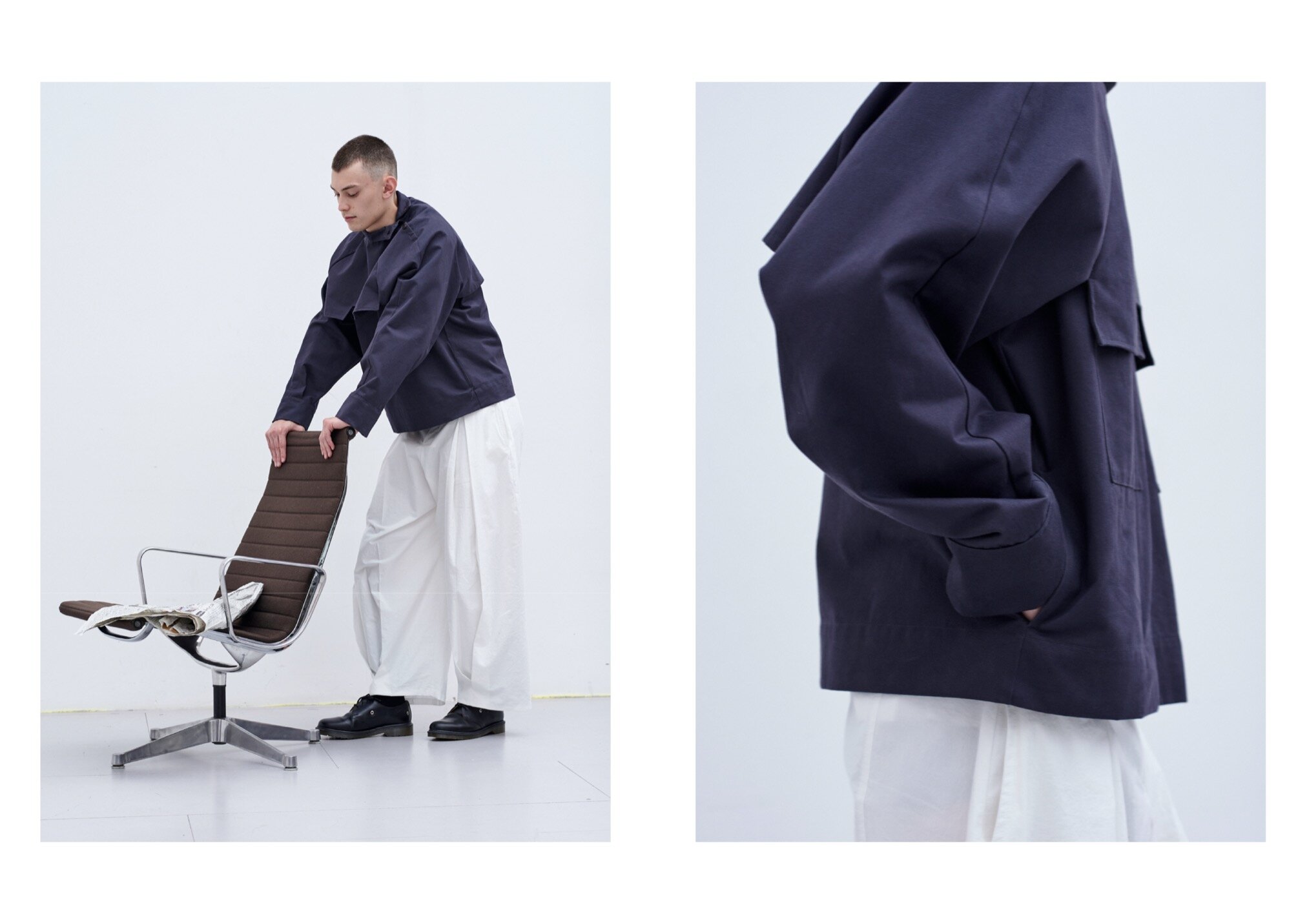INTENTIONAL HARMONY WITH SAGE NATION

Modular design typically begins with clear and straightforward pieces that are universally understood, uniquely interchangeable, and are constructed with the intent to upgrade and evolve.
Much like these core tenets, SAGE NATION holds these principles with the same reverence in regards to the overall design theory for their own collection. What was originally meant to create efficiency in large scale systems, is now being adopted to streamline decision making in the already chaotic time period between when you wake up each morning and when you head out the door to start each day. This collection draws from many inspirations, a few of which stand out more than the others.
History, and an innate natural lean towards subtlety are closely interwoven within each of the pieces that are produced. From hybrid jackets that have detachable components made with heavyweight Japanese cotton, to military-influenced ponchos with the ability to alter it into various forms to suit the needs of the user, the ethos of instantaneous and tangible use comes through loud and clear.
In fact, connecting the concept of clothing that you’ll need to put on everyday with the paradigm of an effortless, get up and go lifestyle is an incredibly overlooked element in the industry. When a piece of clothing’s sole impetus is to serve as conduit for making the already chaotic day easier to manage, a drill down into the nuances of contrast is necessary. For our good friend Sage Toda-Nation and his eponymous brand, SAGE NATION, the aim is clear - creating products that are infinitely adaptable and continually refining his vision of what a “modular wardrobe” looks like through the lens of a young designer with a deep affinity for a predictive use case model. Join us as we explore this topic in-depth with Sage Toda-Nation himself:
Who is Sage Toda-Nation?
Thank you for reaching out to me Sabukaru and allowing me to shed more light on what I do and what the brand SAGE NATION is really about.
I am a 22 year old designer/creative director currently based in East London. I was born in Hokkaido in the north of Japan then moved to Milton Keynes (U.K.) as a child. Growing up I was always drawn to anything visual, the way someone dressed and carried themselves was something that carried a lot of weight for me when it came to initial observations. It sounds cliche but the academic side of school was something I struggled with, my amazing mum dragged me through my GCSE’s and A levels.
I guess you could say I come from a DIY streetwear background when at a young age it was really about making clothes that I loved and couldn’t afford otherwise. I was lucky enough to gain an insight into the idea that being a creative could be a potential career from a young age because my Mother started off as a photographer and my grandfather was an artist. But this is something that I am still learning more about as I get older.
Tell us about your heritage and upbringing. How does it influence your view on the world and inspire your brand?
I think growing up my heritage was something I was always discovering as time went on. It is not something I was fully immersed in since I was young because my parents split when I was young. However my Mother did grow up in Japan as well so that meant that I was always around a lot of Japanese influences. It's a complicated family haha.
I have alway been surrounded by very contrasting environments growing up, different classes in society as well as different cultures. The influences around me were very eclectic, this definitely influences the direction of work. I love subtle contrast, it is everything to me. I get joy from seeing someone wear a full nike tracksuit at CSM and a full made to measure cashmere suit in the barber shop. The contrast in my life is what helps me grow and learn. I enjoy navigating my own lane through my environment.
Your debut collection shows your high attention to detail on material, construction and design - what inspires this?
Well thank you for acknowledging that. As a brand we strive for what we see as perfection in the current moment. I am a nerd when it comes to finishings and construction and the tiny details that make me/us feel good in clothes. We strive for this moment. As a brand we have 3 words that we believe are the core principles that we centre our designs and concepts around. The three words are Purpose, Perspective and Balance, these words are something that binds together whoever works with the brand and friends of the brand. These words provide the foundation of all the decisions made within the brand, from concept realisation and distribution. This allows us to continually grow without straying away from the core ideology.
I feel it is important that as a young designer especially, we push a narrative that is built to last and not just built to create hype that dies. Fabric to me is the most integral part of a garment, it is the canvas that we work with. I am still learning when it comes to the fabric world, but I am happy with the fabrics we have chosen for this collection because I feel they really do have a sense of purpose.
There is a clear deliberate homage to military and combat inspired garments in this debut collection - can you walk us through the process and why you chose this direction for the collection?
Going back to the 3 words we focus on, I am naturally drawn to clothes that have a certain purpose about them and an innate intention. I am aware that we do not need anymore clothes in this world so how do we create clothes with a purpose. This led me to look at combat clothes as an initial starting point for my research. I enjoy studying the subtle influences that combat clothing has had on our everyday clothes as well as making the cross over from British traditional fencing references and traditional kendo in Japan for example.
It is interesting to me to see how the two cultures from other sides of the world have interpreted combat clothing that basically serve the same purpose. It was a good starting point for me to develop some refreshing silhouettes. When it comes to my design process I try to draw my influences from a place where design happened because of a necessity to improve people's lives, this is an interesting point for me to research so naturally military clothing is something I am always looking at.
I am a bit of a nerd when it comes to learning about designers that have managed to integrate their designs into our everyday life that sometimes go unnoticed. A good example being Kenneth Grange, who was responsible for much of the industrial design that is used in the UK today. I like this idea of taking this approach to design but combining it with a visual story that people are drawn to.
Speaking of influences, I read elsewhere that films in particular play an especially important role in your creative process. There is strong imagery that appears throughout the collection and lookbook, is there anything else in your life that helps draw out this same level of spark?
The visual communication of my work is as important as the product for me. I am hugely influenced by a range of film directors and photographers. For example Takeshi Kitano’s movies tend to always find a place in my mood boards and photographers such as Issei Suda, Takashi Homma and Hiroshi Hamaya have always inspired me a lot visually. This layer to the brand is very important to me, it is the way I express a mood or a feeling through my clothes. I don't see myself as a designer who expresses himself through clothing as such but I express myself through the general feeling behind the clothing, which is normally created by imagery. I admire photography a lot and I have a close relationship with the photographers that I use. They understand the brand just as much as I do.
In general also when it comes to clothing I am constantly observing the way people wear things. My colleague Louis and I spend a lot of time looking at the way commuters dress and the consistency they all have. I find it funny how the hard core commuters have their own subculture when it comes to the way they dress that goes unnoticed. It seems to be the Osprey bag is the end boss of commuter rucksacks haha. Also in general I think style comes from wearing your clothes, not letting clothes wear you. I am always inspired by the way my friends can make something I never even saw as cool, seem cool, because of the way they wear it.
What does a “modular wardrobe” truly mean to you?
To me the whole idea of a “modular wardrobe” is that idea of simplifying the process of dressing yourself in the morning. I believe clothes should be stress free and pure and not bring more decisions and complications into one's life. Especially in the current times we can’t afford to have clothes that do not work well in our everyday life. It is my angle on the sustainability argument, clothes should just be purposeful and useful, it only makes sense to me that all the product works well together as a unit.
2020 has been a hell of a year to say the least, how have you been staying motivated and inspired?
Yes 2020 really has been a hell of a year. To be honest the lockdown period allowed me more time to work on the collection and perfect certain things without distraction. One of the ways I stay focused is by enjoying my food, anyone that knows me well knows how much I eat and enjoy food. When I feel lost I just go for a good meal and realign myself.
I keep good company with people around me who constantly keep me motivated and in check. Also I think it is important to self analyse yourself and critique yourself just as much as you do others. For me, 2020 has been a year of understanding my strengths and weaknesses more, as well as establishing the right route forward.
Where do you end up spending most of your time nowadays, and why?
Normally in my favourite pub in London ‘The Cocoanut’ in Kingston Listening to some heavy drill music and some Toni Braxton whilst eating a Pad Thai. (The cocoanut serves the best Thai food in the game).
What’s next for SAGE NATION?
The goal moving forward is to really just refine what we do further and strive for better. I have big plans for the coming year, but more importantly I want things to grow with a strong foundation. I also have plans besides the brand to work on more of a consultancy basis for projects that I feel I can bring something to. It is important to me to not only be working within the realm of clothing but also other areas of design and direction. I am still young but I am here for the long run.
Thank you for your time!
Credits:
Interview by Charlie Duong
Text by Joseph Wang
Images provided by SAGE NATION
About The Authors:
Joseph Wang is a Washington D.C. based storyteller focused on the history and influence that brands have on people, and vice versa. Connecting these stories to his roots, and immersing them with context and close relationships are what he strives for.
Charlie Duong is an Amsterdam based designer and writer. He utilizes fashion, music, and technology as a medium to shed light on individuals, culture, and design thinking.































